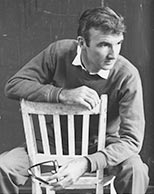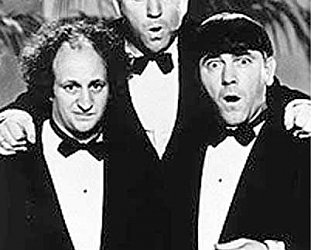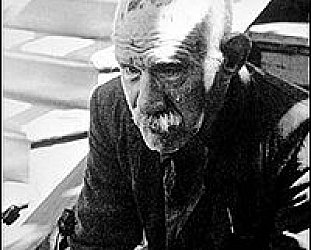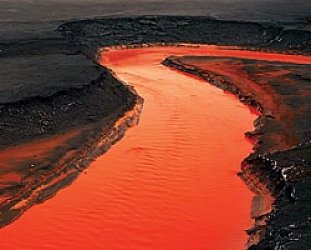Graham Reid | | 4 min read

When a history of animated film is written, it is possible that the largest chapter about how this genre emerged will go not to Walt Disney or Otto (Felix the Cat) Mesmer but to a modest quietly spoken Scots-born Canadian, Norman McLaren.
McLaren’s whimsical films charmed and delighted audiences for nearly 50 years.
He entered the Glasgow School of Art at the age of 18 to study interior design and in 1934 had his first contact with film through the Glasgow Film Society; he fell in love with the medium and joined a film production club.
Even from the outset, McLaren was different. For his first film he used discarded film stock which he soaked in a bathtub until it was clear; he then painted directly on to the surface in clear dyes.
McLaren’s second film won first prize in the second amateur Film Festival in Glasgow in 1934 and his third, also a prize winner in the festival of the following year, was spotted by the influential English film-maker John Grierson, who offered McLaren a position in the General Post Office Film Unit in London.
McLaren was on his way.
After brief stint in Spain acting as cameraman during the Spanish Civil War, McLaren returned to London to embark on a remarkable three years of work.
His lively, animated works where household objects moved around the room or where curious shapes slithered around the screen, enlivened the dull subjects he was working on – the production of the London telephone directory, why you should save with the Post Office and how letters reach their destinations.
By a remarkable coincidence the New Zealand film-maker Len Lye was also working the same department and, independent of McLaren, was exploring ideas of drawing directly on to film.
When he first saw a McLaren film, Lye was powerfully impressed.
“There I was looking when suddenly there came this meat cleaver of a film effect. It split me clean down to the middle of my spine.”
For his part, the modest McLaren always said that Lye’s films “were much much better than my own. Very beautiful.”
After two years of further experimentation in New York, McLaren was tempted to Canada by Grierson who had established the National Film Board of Canada. It was 1941 and McLaren, a lifelong pacifist, agreed on the condition that he did not have to make hard-sell propaganda films.
Grierson, recognising McLaren’s unique talent, arranged for the artist to be given an almost entirely free hand.
In Ottawa, McLaren again embarked on a remarkable serious of short animated pieces: whimsical figures dance across the screen, changing shape continually to warn of inflation and the need for price control; a human skull is animated in Keep Your Mouth Shut as part of the wartime anti-gossip campaign, and always McLaren experimented with colouring directly on to film.
In 1949 McLaren was invited to China as part of a Unesco project to teach Chinese artists who to use film strips (often hand-drawn) to teach hygiene to villagers. While there, he witnessed the takeover of his area by the communist forces.
He was impressed by what he saw them doing in the way of village improvements, education and organisation, and on his return to Canada, in his own quiet way, said as much.
But Canada was gripped in Cold War fever and McLaren was surprised at the hostility his favourable impressions of Chinese communists aroused. He put his feelings about the divisiveness of political ideals into a remarkable and moving film, Neighbours, in 1952.
Two neighbours, initially at ease with each other, begin an increasingly violent battle over possession of a flower which suddenly appears in their garden, each claiming it for his own. The fight over the flower leads to the destruction of their homes, the murder of their families and their eventual deaths – buried under a flower-covered grave.
Not only was the story unusual for its violence, but the action, using two of McLaren’s friends, and the sound were all animated. The sound was animated by McLaren drawing notes which were photographed on to the soundtrack area of the film.
Although his health became increasingly poor as the result of his period in China, McLaren continued to make more and more innovative films for the National Film Board.
Whether the effects were achieved by scratching on film or by quietly shifting spheres that move in and out of each other and through geometric arrangements to the accompaniment of Bach music, a McLaren film was always worth seeing.
Among his finest were the beautiful Pas de Deux of 1967, where two ballet dancers are filmed in slow motion and the multiple exposures create a graceful rhythm of abstract motion and his 1971 film, Synchromy, in which the hand-drawn soundtrack is extended over the width of the frame and is coloured. The effect is that “what you see is what you hear.”
Norman McLaren’s films were widely known, especially in New Zealand. A 1970 film about McLaren by Gavn Miller, appropriately entitled The Eye Hears, the Ear Sees was in the National Film Library along with half of dozen other McLaren films. They were all used regularly in film courses in schools and universities through New Zealand during the 70s and 80s and have been the inspiration for many students to try similar direct-to-film drawing experiments.
Many years ago I began a correspondence with McLaren, simply to thank him for a lifetime of original films and the inspiration he had been to film students of mine.
His replies were full of his characteristic humility and delight that they had made young people interested in film. His last letter in a very shaky hand noted that being 70 he had retired from the National Film Board; in later years he had been working extremely slowly, taking six months to produce a few minutes of his characteristic magic.
When Norman McLaren died in Quebec in 1987 at age 72, he left behind a body of work unequalled in the history of animated film.
More than awards (of which he gathered many), Norman McLaren won respect -- and friends.







John Ringer - Dec 8, 2008
In the 1970s I took over running the summer holiday movies in the Matapouri Hall from Sam Stewart. Sam was a reed-thin, silver-haired and gracefully polite local identity who owned the Matapouri store, and as one did in those days, volunteered for everything else that needed doing locally. Matapouri then was a long drive from Whangarei over dry dusty windy metal roads so going back into town for a show was an ordeal. By the time I arrived in the village Sam was wearing out, so I persuaded him (and the Hall Society) that my interest in film was enough to take over after a period of training on his old 16mm projector. And with a bit of local marketing we decided to extend the holiday films to an all year round attraction. Kerridge Odeon supplied the 3- or 4-reel commercial movies but we couldn't afford more than one a month, and also wanted to have a full programme (shorts plus the main) so did a bit of research into what was available free, and discovered the rich cultural resources available from various Embassies and Consulates. The absolute pick of these were the UK and Canadian collections, and WOW the Canadians allowed access to virtually the entire National Film Board of Canada catalogue. The riches included of course Norman McLaren - who we were amazed to discover as we knew of Len Lye, and one local artist was already experimenting with hand drawn 8mm film. Norman was something else - his shorts were astonishing in their originality and inventiveness. So over the next few years we became I suspect the most cinematically intelligent audience in the country, on a wholesome diet of McLaren, Lye, Sam Pekinpah et al. In summer, the audience packed the hall out, and with two intervals between reels everyone made a quick dash over the road for ice creams from Sam's shop. Perhaps he'd long since worked out that the movies were probably the easiest way by far to increase turnover. One outstanding short from the UK that I still remember every scene of was 'Harold Bate: Sweet as a nut'. He ran his old Hillman with a chicken shit digester on the running board, an adaptation from the coal gas burners of the war. Where is Harold now when we need him!
Savepost a comment